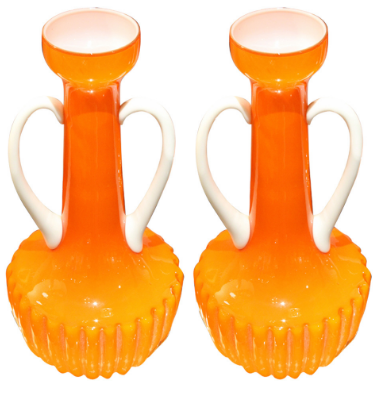In the captivating realm of glass artistry, a technique that has garnered admiration and fascination for centuries is cased glass. This remarkable process involves layering multiple layers of glass to create intricate and visually stunning pieces that play with color, depth, and transparency. Cased glass has left an indelible mark on the world of decorative arts, boasting a rich history and an enduring appeal that continues to captivate both artists and collectors alike.

The Essence of Cased Glass:
Cased glass, often referred to as “overlay glass,” involves encapsulating a layer of colored glass within a clear or transparent outer layer. This technique creates a captivating interplay between the inner color and the outer clarity, resulting in a piece that appears to glow from within. The depth and vibrancy of cased glass pieces depend on the number of layers used and the skill of the glassmaker in achieving the desired effect.
A Journey Through Time:
The origins of cased glass can be traced back to ancient civilizations, where artisans experimented with layering glass to create intricate patterns and designs. However, it was during the 19th century that cased glass truly blossomed as a refined and sought-after art form. European glasshouses, particularly those in Bohemia (now part of the Czech Republic) and Italy, played a pivotal role in perfecting the cased glass technique, producing exquisite pieces that adorned the homes of royalty and aristocrats.
The Creation Process:
Crafting cased glass is a delicate and precise process that requires a skilled glassmaker’s expertise. The steps involved include:
- Gathering and Shaping: The glassmaker gathers a molten blob of clear or colored glass on the end of a blowpipe. The glass is then manipulated and shaped into the desired form, whether it’s a vase, bowl, or other decorative item.
- Layering: Once the initial layer is shaped, the glassmaker adds additional layers of colored glass. The inner layer determines the piece’s overall color and character, while the outer layer provides the clarity and protective coating.
- Fusing and Shaping: The multiple layers of glass are carefully fused together through controlled heating in a kiln. The glassmaker continues to shape and manipulate the piece, ensuring the layers meld seamlessly.
- Finishing Touches: Once the desired form is achieved, the glass is cooled gradually to avoid cracking or stress. The piece may then undergo cutting, engraving, or other decorative techniques to enhance its beauty further.
Variations and Styles:
Cased glass comes in a variety of styles, each showcasing the glassmaker’s creativity and mastery of the technique. Some of the notable variations include:
- Cameo Glass: This intricate style involves etching away the outer layer to reveal the underlying colored glass, creating intricate designs and patterns in relief.
- Millefiori Glass: Millefiori, meaning “a thousand flowers” in Italian, involves embedding colorful glass canes or rods into the layers, creating intricate and vibrant patterns reminiscent of flowers.
- Rainbow Glass: Rainbow glass utilizes multiple layers of transparent colored glass to achieve a mesmerizing spectrum of colors that shift and blend as light passes through.
Collectors’ Treasures:
Cased glass has long been cherished by collectors for its beauty, craftsmanship, and historical significance. Antique cased glass pieces are often prized possessions, showcasing the artistic prowess of their creators and the era in which they were made.
A Timeless Art Form:
Cased glass stands as a testament to the enduring allure of glass as a medium for artistic expression. Its ability to meld color and clarity, creating a captivating dance of light and depth, speaks to the harmony between artistic vision and technical skill. Whether displayed in grand museums, admired in private collections, or showcased in everyday settings, cased glass continues to illuminate the delicate balance between tradition and innovation in the ever-evolving world of glass artistry.
Read more for best glass pots and pans


